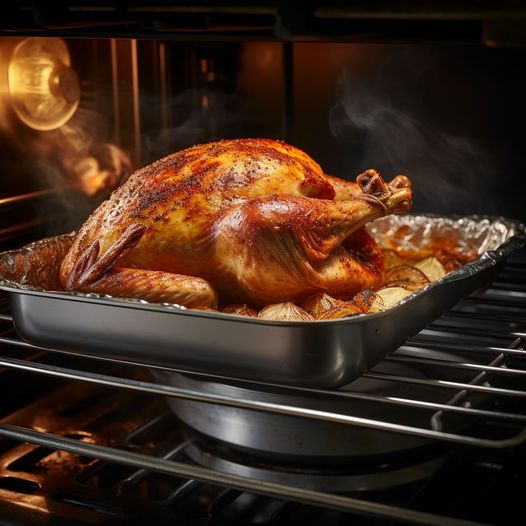ADVERTISEMENT
So, Should You Add Water? Here’s What You Need to Consider:
1. For Moisture and Gravy:
If you want to make sure your turkey stays juicy and are also looking to create a flavorful gravy, adding a small amount of water to the pan is a good option. Here’s how to do it:
- Add Water Sparingly: You don’t need to fill the pan with water. A cup or two of water is typically enough to create a steamy environment that helps keep the turkey moist.
- Use Aromatics: For additional flavor, you can infuse the water with aromatics like onions, garlic, celery, and herbs like rosemary and thyme. These flavors will infuse the turkey as it roasts, making the drippings and gravy even tastier.
- Basting: If you prefer to baste your turkey, the water in the pan can help keep the juices from burning. However, frequent basting is generally not necessary. You can let the turkey roast undisturbed to help the skin crisp up and still achieve a juicy bird.
2. For Crisp Skin:
If your goal is to achieve crispy, golden skin on your turkey, the best method is to avoid adding water to the pan. This allows the skin to crisp up as it roasts at high heat, which is essential for that perfect turkey skin. Here’s what you can do instead:
- Roast at High Heat: Start roasting the turkey at 400-425°F (200-220°C) for the first 30-40 minutes. This high heat helps brown and crisp the skin. Then, reduce the heat to 350°F (175°C) for the remainder of the cooking time.
- Use Butter or Oil: To help the skin brown and crisp, rub the turkey with butter, oil, or a combination of both. This adds flavor and helps the skin become golden and crunchy.
- Dry Brining: Some cooks prefer to dry brine their turkey in advance by rubbing it with salt and letting it sit uncovered in the fridge for 24-48 hours. This helps to draw moisture to the surface and creates a more flavorful, crispy skin once roasted.
3. The Modern Roasting Method:
In recent years, many chefs and home cooks have embraced spatchcocking (butterflying) the turkey, which allows for more even cooking and faster roasting. When using this method, adding water to the pan isn’t necessary, as the turkey is positioned flat and cooks more evenly.
If you’re using a roasting rack (which elevates the turkey off the bottom of the pan), it’s also unnecessary to add water. The rack ensures that the turkey cooks in the dry heat of the oven, allowing the skin to crisp and the juices to drip below into the pan for making gravy.
Tips for Perfectly Roasting a Turkey Without Water
- Use a Roasting Rack: Elevating the turkey on a rack helps hot air circulate around the bird, ensuring even cooking and allowing the skin to get crispy without added moisture.
- Avoid Basting: While it’s tempting, avoid basting the turkey during cooking. Opening the oven frequently lowers the temperature and can make the skin soggy. Let the oven do the work and allow the turkey to brown undisturbed.
- Don’t Overcook: Keep an eye on the internal temperature to avoid overcooking the turkey. The perfect turkey should reach 165°F (74°C) in the thickest part of the breast and 180°F (82°C) in the thighs.
- Rest After Roasting: Once your turkey is done, allow it to rest for at least 20-30 minutes before carving. This lets the juices redistribute within the meat, ensuring a moist turkey when you carve it.
Conclusion: Add Water or Not?
The choice of whether or not to add water to your turkey roasting pan ultimately comes down to your personal preferences and cooking goals. If you’re focused on creating a moist turkey and a rich gravy, adding a small amount of water can be helpful. However, if crispy skin and flavorful browning are your top priorities, it’s best to roast the turkey without any added water.
Remember, the key to a great turkey is achieving the right balance of moisture and crispiness. Whichever method you choose, with the right preparation and attention to detail, you’ll have a deliciously roasted turkey that’s sure to impress your family and guests!
ADVERTISEMENT
